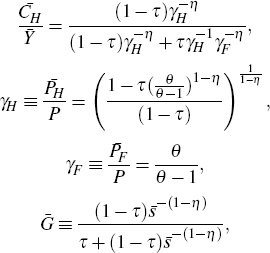RDP 2013-06: Estimating and Identifying Empirical BVAR-DSGE Models for Small Open Economies Appendix B: Log-linearised Equations of the DSGE Model
June 2013 – ISSN 1320-7229 (Print), ISSN 1448-5109 (Online)
- Download the Paper 759KB
These equations are based on code provided by Bruce Preston. I make two changes, namely eliminating the nominal exchange rate from the Taylor rule (and hence the model), which removes the need to include the real exchange rate identity, and making the steady-state mark-up of the small economy importers depend on the small economy elasticity of substitution, rather than the large economy's elasticity (although these were calibrated to be the same). The notation follows Justiniano and Preston (2010a), except that πt denotes log-linearised inflation. I denote US variables with a *, log-linearised variables in lower case, the jth shock by εj,t, and the innovation to it by vj,t.
B.1 Variables
The mnemonics for the variables are given in Table B1.
| Mnemonic | Variable | Mnemonic | Variable |
|---|---|---|---|
| y | Output | s | Terms of trade |
| i | Nominal interest rate | q | Real exchange rate |
| π | Inflation | z | Net foreign assets |
| w | Real wages | πF | Imports inflation |
| πw | Nominal wage inflation | Shocks | |
| n | Hours worked |  |
Foreign cost-push |
| c | Consumption | εn | Labour disutility |
| CH | Consumption of home goods | εa | Technology |
| Y | Level of output | εi | Monetary policy |
 |
Rp of domestic goods | øt | Risk premium |
 |
Rp of imports | εg | Preference |
| ψF | Law on one price gap | ||
| Note: Rp denotes relative price to consumption | |||
B.2 Large Economy
IS curve
Price Phillips curve
where
and  ,
where f* denotes the production function. Following
,
where f* denotes the production function. Following
Justiniano and Preston (2006) this is calibrated at 0.33.
Wage Phillips curve
Where
and
Real wages
Labour
Taylor rule
Preference shock
Technology shock
Labour disutility shock
B.3 Small Economy
Euler equation
Market clearing
where
and
Terms of trade
Change in the terms of trade
Law of one price
Net foreign assets
Uncovered interest parity
Change in the real exchange rate
Wage inflation
where
and
Real wage
Labour
Taylor rule
Domestic good inflation
where
and  where f denotes the production function. Following Justiniano and Preston
(2006) this is calibrated at 0.33.
where f denotes the production function. Following Justiniano and Preston
(2006) this is calibrated at 0.33.
Foreign good inflation
where
CPI
Preference shock
Technology shock
Labour disutility shock
Risk premium shock
Cost-push imports





































